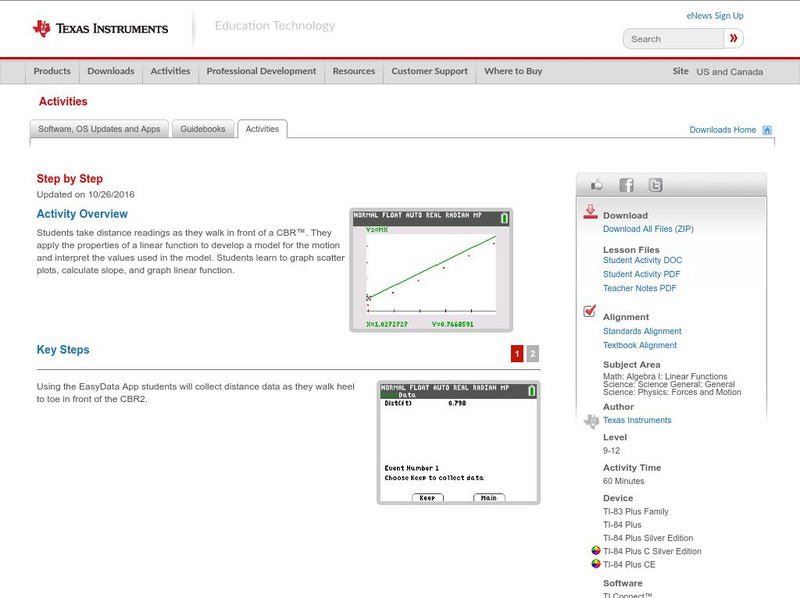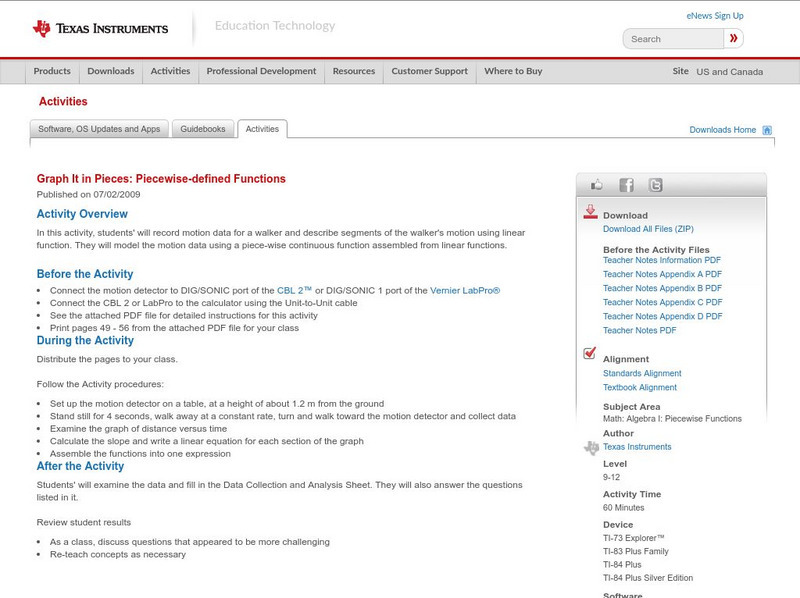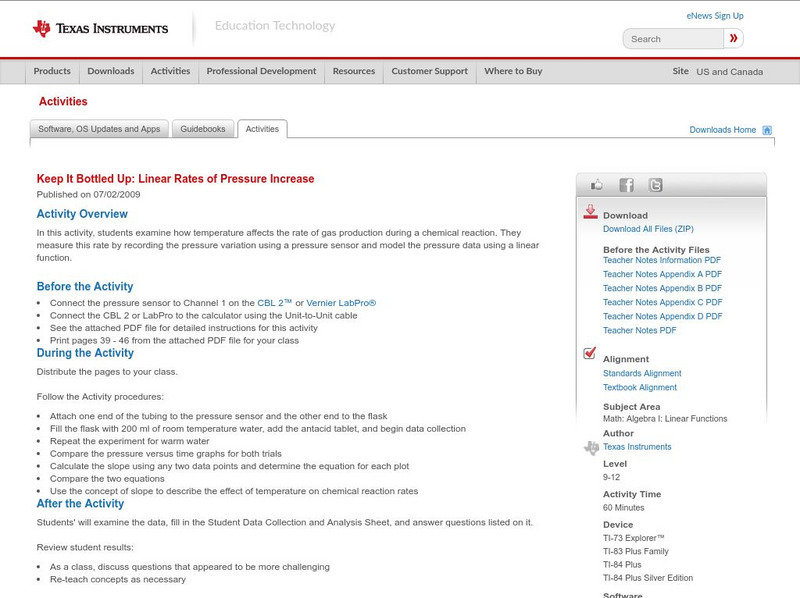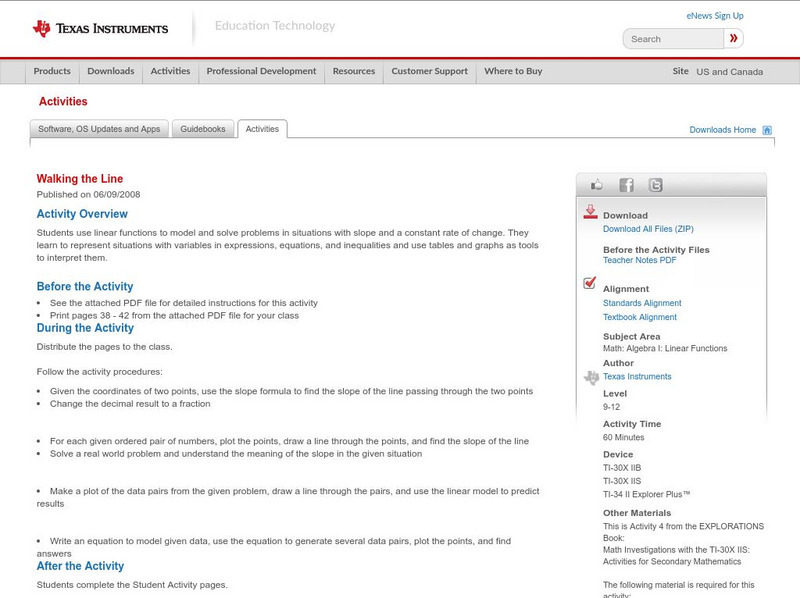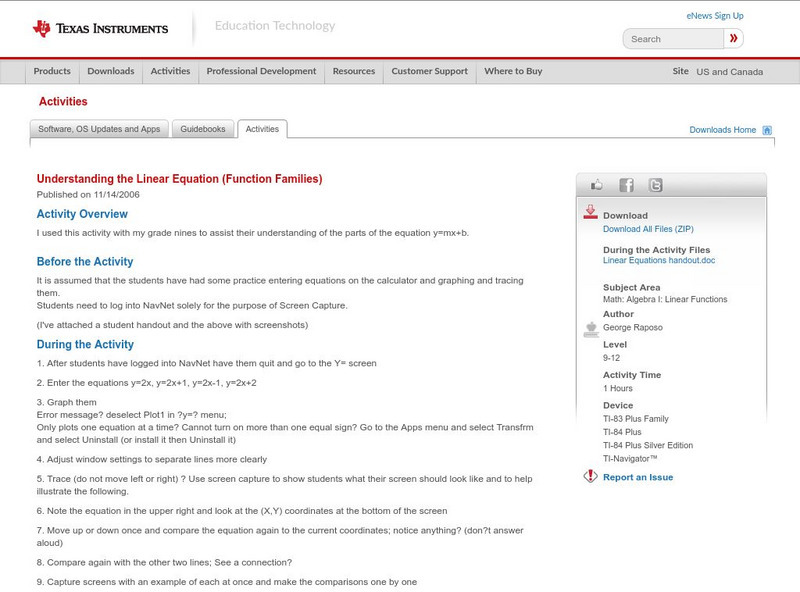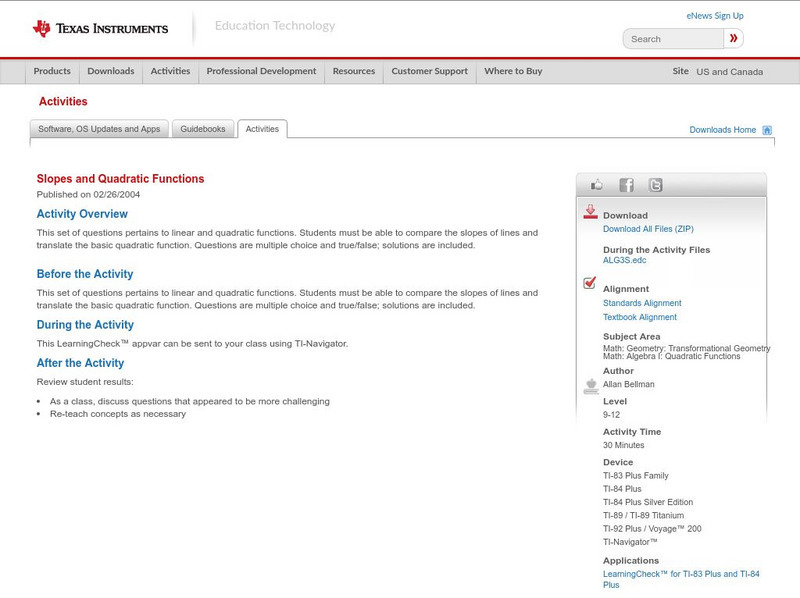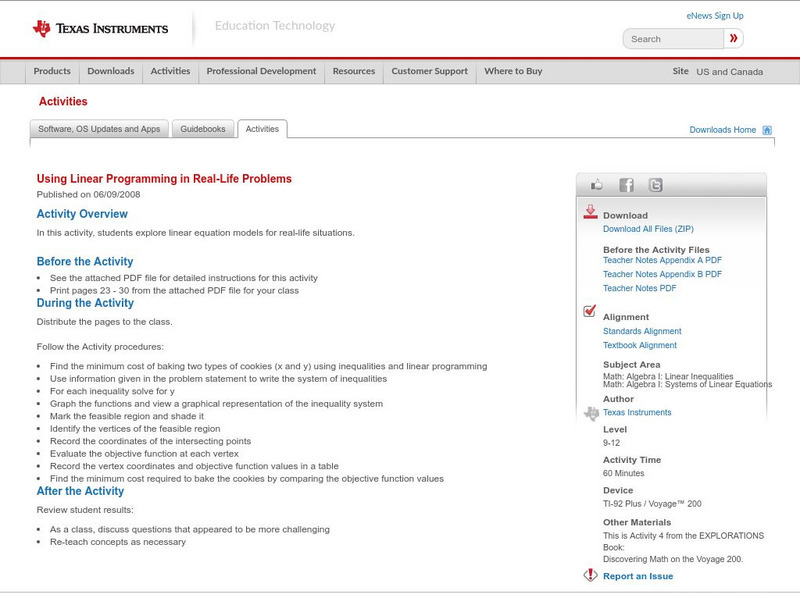Hi, what do you want to do?
Shodor Education Foundation
Shodor Interactivate: Function Machine
Students investigate very simple functions by trying to guess the algebraic form from inputs and outputs.
Texas Instruments
Texas Instruments: Linear Functions: Slope as Rate of Change
Students learn to associate the slope of a straight line with a constant rate of change. They also learn to calculate the rate of change from data points on a line, using the correct units. Students also learn to read from a linear...
Texas Instruments
Texas Instruments: Step by Step
In this activity, students take distance readings as they walk in front of a CBR. They apply the properties of a linear function to develop a model for the motion and interpret the values used in the model. Students learn to graph...
Texas Instruments
Texas Instruments: C Ds Anyone?
In this activity, students write rules for real world functions. They make a table to compare function values and graph linear functions on the coordinate plane.
Texas Instruments
Texas Instruments: Graph It in Pieces: Piecewise Defined Functions
In this activity, students' will record motion data for a walker and describe segments of the walker's motion using linear function. They will model the motion data using a piece-wise continuous function assembled from linear functions.
Texas Instruments
Texas Instruments: Form a Line Using Ti Navigator
In this lesson concept we use the Activity Center to build some basics in students understanding of linear functions. The linear relationship is clearly one of the big ideas of the algebra curriculum, and it paves the way for a deeper...
Texas Instruments
Texas Instruments: Take the Train
In this activity, students collect information about the stops made, time taken, and distance covered by a train on one of Amtrak's routes. They find a mathematical model that can best track the train. Students understand concepts...
Texas Instruments
Texas Instruments: Keep It Bottled Up: Linear Rates of Pressure Increase
In this activity, students' examine how temperature affects the rate of gas production during a chemical reaction. They measure this rate by recording the pressure variation using a pressure sensor and model the pressure data using a...
Texas Instruments
Texas Instruments: Walking the Line
In this activity, students use linear functions to model and solve problems in situations with slope and a constant rate of change. They learn to represent situations with variables in expressions, equations, and inequalities and use...
Texas Instruments
Texas Instruments: Where Should They Hold the Fundraising Party?
Students learn how to create a table of values for a simple linear function and use the table to create a graph on squared paper. They use the graphing calculator to display the ordered pairs and find values of corresponding to values of...
Texas Instruments
Texas Instruments: Polynomial Addition, Subtraction
This StudyCard stack teaches that, when linear functions are added, the slope of the sum is equal to the sum of the slopes, likewise for y-intercepts. Includes quadratic and up polynomials.
Texas Instruments
Texas Instruments: Step Up
Students learn to use measurements on a real model to develop the concept of slope and linear functions. They use a calculator to explore changing the slopes and Y- intercepts in the slope intercept form Y = MX + B.
Texas Instruments
Texas Instruments: Solve Linear Equation
This StudyCards set begins with "what is an equation?" and continues with solving linear equations using the graph of the related linear function(s), the trace and zeros methods.
Shodor Education Foundation
Shodor Interactivate: Linear Function Machine
An interactive "machine" allows you to see first hand how a function works. Enter several input values, receive the output values, and determine the algebraic function.
Alabama Learning Exchange
Alex: Math Is Functional
This activity is a technology-based activity in which students extend graphing of linear functions to the use of spreadsheet software. After students have become proficient in constructing a table of values, students are able to...
Texas Instruments
Texas Instruments: What Is Gravity? Activity Modeling Motion
This activity serves as a follow-up to Activity 4 in the Explorations book, Modeling Motion: High School Math Activities with the CBR by Linda Antinone, Sam Gough, and Jill Gough (Texas Instruments Incorporated, 1997).
Texas Instruments
Texas Instruments: Linear and Quadratic Approximations
In this activity, students explore the linear and quadratic approximations of a logarithmic function and find properties the functions have in common.
Texas Instruments
Texas Instruments: Understanding the Linear Equation (Function Families)
This activity can be used with ninth graders to assist their understanding of the parts of the equation y=mx+b.
Texas Instruments
Texas Instruments: Using Activity Center: Slope/y Intercepts of Linear Equation
The teacher will submit an equation using activity center but will not show the students the equation.
Texas Instruments
Texas Instruments: Slopes and Quadratic Functions
This set of questions pertains to linear and quadratic functions. Students must be able to compare the slopes of lines and translate the basic quadratic function. Questions are multiple choice and true/false; solutions are included.
Texas Instruments
Texas Instruments: Using Linear Programming in Real Life Problems
In this activity, students explore linear equation models for real-life situations.
Shodor Education Foundation
Shodor Interactivate: Function Flyer
This activity allows the manipulation of the constants and coefficients in any function thereby encouraging the user to explore the effects on the graph of the function by changing those numbers.
Alabama Learning Exchange
Alex: Parent Functions and Their Children
For this lesson, learners will be able to identify parent functions of linear functions, absolute value functions, and quadratic functions. Students will be presented with functions and asked to graph them by first identifying the basic...
University of Waterloo (Canada)
Univ. Of Waterloo: Wired Math: Linear Graphing: Graphing and Analyzing [Pdf]
The mathematics resource assesses students on linear relations. The activity has problems with graphing and analyzing linear relations. Some of the topics included are variation, scatter plots and linear relationships. The worksheet has...







